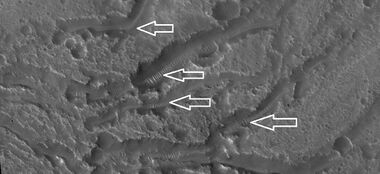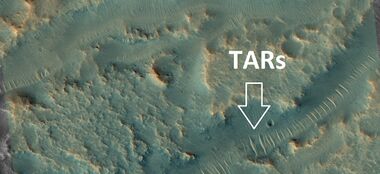Difference between revisions of "Transverse Aeolian ridges (TARs)"
(added ref) |
|||
| Line 1: | Line 1: | ||
Transverse Aeolian ridges (TARs) are light-toned features typically found in spots on Mars, especially on the floors of channels. Thus they sever as markers for where channels are located. They were first seen in narrow-angle images from the Mars Global Surveyor Mars Orbiter Camera (MOC). Even though TARs are widespread on Mars, their formation, age, and composition are not totally understood. | Transverse Aeolian ridges (TARs) are light-toned features typically found in spots on Mars, especially on the floors of channels. Thus they sever as markers for where channels are located. They were first seen in narrow-angle images from the Mars Global Surveyor Mars Orbiter Camera (MOC). Even though TARs are widespread on Mars, their formation, age, and composition are not totally understood. | ||
| − | <ref>Berman, Daniel C.; Balme, Matthew R.; Rafkin, Scot C.R.; Zimbelman, James R. (2011). "Transverse Aeolian Ridges (TARs) on Mars II: Distributions, orientations, and ages". Icarus. 213 (1): 116–130. Bibcode:2011Icar..213..116B. doi:10.1016/j.icarus.2011.02.014. ISSN 0019-1035.</ref> <ref> Balme, Matt; Berman, Daniel C.; Bourke, Mary C.; Zimbelman, James R. (2008). "Transverse Aeolian Ridges (TARs) on Mars". Geomorphology. 101 (4): 703–720. Bibcode:2008Geomo.101..703B. doi:10.1016/j.geomorph.2008.03.011. ISSN 0169-555X. </ref> <ref> Wilson, Sharon A. (2004). "Latitude-dependent nature and physical characteristics of transverse aeolian ridges on Mars". Journal of Geophysical Research. 109 (E10): E10003. Bibcode:2004JGRE..10910003W. doi:10.1029/2004JE002247. ISSN 0148-0227. </ref> <ref> Bridges, N. T.; Bourke, M. C.; Geissler, P. E.; Banks, M. E.; Colon, C.; Diniega, S.; Golombek, M. P.; Hansen, C. J.; Mattson, S.; McEwen, A. S.; Mellon, M. T. (2012). "Planet-wide sand motion on Mars". Geology. 40 (1): 31–34. Bibcode:2012Geo....40...31B. doi:10.1130/G32373.1. ISSN 0091-7613. </ref> <ref>Geissler, Paul E.; Wilgus, Justin T. (2017). "The morphology of transverse aeolian ridges on Mars". Aeolian Research. 26: 63–71. Bibcode:2017AeoRe..26...63G. doi:10.1016/j.aeolia.2016.08.008. </ref> <ref> Geissler, Paul E. (2014). "The birth and death of transverse aeolian ridges on Mars: Transverse Aeolian Ridges on Mars". Journal of Geophysical Research: Planets. 119 (12): 2583–2599. doi:10.1002/2014JE004633. </ref> <ref> Wilson, Sharon A. (2015), "Transverse Aeolian Ridge (TAR)", in Hargitai, Henrik; Kereszturi, Ákos (eds.), Encyclopedia of Planetary Landforms, New York, NY: Springer, pp. 2177–2185, doi:10.1007/978-1-4614-3134-3_380, ISBN 978-1-4614-3134-3, retrieved 2020-09-16 </ref> | + | <ref>Berman, Daniel C.; Balme, Matthew R.; Rafkin, Scot C.R.; Zimbelman, James R. (2011). "Transverse Aeolian Ridges (TARs) on Mars II: Distributions, orientations, and ages". Icarus. 213 (1): 116–130. Bibcode:2011Icar..213..116B. doi:10.1016/j.icarus.2011.02.014. ISSN 0019-1035.</ref> <ref> Balme, Matt; Berman, Daniel C.; Bourke, Mary C.; Zimbelman, James R. (2008). "Transverse Aeolian Ridges (TARs) on Mars". Geomorphology. 101 (4): 703–720. Bibcode:2008Geomo.101..703B. doi:10.1016/j.geomorph.2008.03.011. ISSN 0169-555X. </ref> <ref> Wilson, Sharon A. (2004). "Latitude-dependent nature and physical characteristics of transverse aeolian ridges on Mars". Journal of Geophysical Research. 109 (E10): E10003. Bibcode:2004JGRE..10910003W. doi:10.1029/2004JE002247. ISSN 0148-0227. </ref> <ref> Bridges, N. T.; Bourke, M. C.; Geissler, P. E.; Banks, M. E.; Colon, C.; Diniega, S.; Golombek, M. P.; Hansen, C. J.; Mattson, S.; McEwen, A. S.; Mellon, M. T. (2012). "Planet-wide sand motion on Mars". Geology. 40 (1): 31–34. Bibcode:2012Geo....40...31B. doi:10.1130/G32373.1. ISSN 0091-7613. </ref> <ref>Geissler, Paul E.; Wilgus, Justin T. (2017). "The morphology of transverse aeolian ridges on Mars". Aeolian Research. 26: 63–71. Bibcode:2017AeoRe..26...63G. doi:10.1016/j.aeolia.2016.08.008. </ref> <ref> Geissler, Paul E. (2014). "The birth and death of transverse aeolian ridges on Mars: Transverse Aeolian Ridges on Mars". Journal of Geophysical Research: Planets. 119 (12): 2583–2599. doi:10.1002/2014JE004633. </ref> <ref> Wilson, Sharon A. (2015), "Transverse Aeolian Ridge (TAR)", in Hargitai, Henrik; Kereszturi, Ákos (eds.), Encyclopedia of Planetary Landforms, New York, NY: Springer, pp. 2177–2185, doi:10.1007/978-1-4614-3134-3_380, ISBN 978-1-4614-3134-3, retrieved 2020-09-16 </ref> <ref>https://www.uahirise.org/ESP_042625_1655</ref> |
<gallery class="center" widths="380px" heights="360px"> | <gallery class="center" widths="380px" heights="360px"> | ||
Latest revision as of 05:29, 10 September 2022
Transverse Aeolian ridges (TARs) are light-toned features typically found in spots on Mars, especially on the floors of channels. Thus they sever as markers for where channels are located. They were first seen in narrow-angle images from the Mars Global Surveyor Mars Orbiter Camera (MOC). Even though TARs are widespread on Mars, their formation, age, and composition are not totally understood. [1] [2] [3] [4] [5] [6] [7] [8]
Aeolian bedforms
Features that used the wind for their formation, Aeolian bedforms, are usually classified as dunes or ripple marks ( which are much smaller).[9] [10] Dunes are taller than 0.5 m or taller on Earth and usually display an asymmetrical cross section. Wind ripples are much smaller—being only 0.6 - 15 mm high. Ripples are more symmetrical in profile and are created by sand grains bouncing along: this process is called “saltation” by geologists. But, TARs are several orders of magnitude larger than wind ripples observed on Mars or Earth.[11] [12] [13] [14] [15] On Mars, TARs represent some intermediate form with characteristics of both ripple marks and dunes. [16] [17] [18] [19] [20]
Furthermore, while TARs and dunes both seem to be composed of the dark volcanic mineral basalt. TARs are generally lighter in color and have lower thermal inertias than dunes. Hard, rocky materials have a higher thermal inertia. Scientists believe that the lower thermal inertia means that the surface of TARs is composed of smaller particles than dunes. [21] [22] [23]
Although a 2020 study found evidence that some isolated TARs could still be moving a small amount, but most studies suggests they do not move.[24]
Images of TARs
References
- ↑ Berman, Daniel C.; Balme, Matthew R.; Rafkin, Scot C.R.; Zimbelman, James R. (2011). "Transverse Aeolian Ridges (TARs) on Mars II: Distributions, orientations, and ages". Icarus. 213 (1): 116–130. Bibcode:2011Icar..213..116B. doi:10.1016/j.icarus.2011.02.014. ISSN 0019-1035.
- ↑ Balme, Matt; Berman, Daniel C.; Bourke, Mary C.; Zimbelman, James R. (2008). "Transverse Aeolian Ridges (TARs) on Mars". Geomorphology. 101 (4): 703–720. Bibcode:2008Geomo.101..703B. doi:10.1016/j.geomorph.2008.03.011. ISSN 0169-555X.
- ↑ Wilson, Sharon A. (2004). "Latitude-dependent nature and physical characteristics of transverse aeolian ridges on Mars". Journal of Geophysical Research. 109 (E10): E10003. Bibcode:2004JGRE..10910003W. doi:10.1029/2004JE002247. ISSN 0148-0227.
- ↑ Bridges, N. T.; Bourke, M. C.; Geissler, P. E.; Banks, M. E.; Colon, C.; Diniega, S.; Golombek, M. P.; Hansen, C. J.; Mattson, S.; McEwen, A. S.; Mellon, M. T. (2012). "Planet-wide sand motion on Mars". Geology. 40 (1): 31–34. Bibcode:2012Geo....40...31B. doi:10.1130/G32373.1. ISSN 0091-7613.
- ↑ Geissler, Paul E.; Wilgus, Justin T. (2017). "The morphology of transverse aeolian ridges on Mars". Aeolian Research. 26: 63–71. Bibcode:2017AeoRe..26...63G. doi:10.1016/j.aeolia.2016.08.008.
- ↑ Geissler, Paul E. (2014). "The birth and death of transverse aeolian ridges on Mars: Transverse Aeolian Ridges on Mars". Journal of Geophysical Research: Planets. 119 (12): 2583–2599. doi:10.1002/2014JE004633.
- ↑ Wilson, Sharon A. (2015), "Transverse Aeolian Ridge (TAR)", in Hargitai, Henrik; Kereszturi, Ákos (eds.), Encyclopedia of Planetary Landforms, New York, NY: Springer, pp. 2177–2185, doi:10.1007/978-1-4614-3134-3_380, ISBN 978-1-4614-3134-3, retrieved 2020-09-16
- ↑ https://www.uahirise.org/ESP_042625_1655
- ↑ https://www.sciencedirect.com/science/article/pii/S0019103521003079
- ↑ Day, M. and J. Zimbelan. 2021. Ripples, megaripples, and TARs, Oh, My! Recommendations regarding Mars aeolian bedform terminology. Icarus. Volume 369, 114647
- ↑ Vriend, N. M.; Jarvis, P. A. (2018). "Between a ripple and a dune". Nature Physics. 14 (7): 641–642. Bibcode:2018NatPh..14..641V. doi:10.1038/s41567-018-0113-0. ISSN 1745-2473. S2CID 125921951.
- ↑ Anderson, R (1990). "Eolian ripples as examples of self-organization in geomorphological systems". Earth-Science Reviews. 29 (1–4): 77–96. doi:10.1016/0012-8252(0)90029-U.
- ↑ Boulton, J. Wayne (1997). Quantifying the morphology of aeolian impact ripples formed in a natural dune setting. National Library of Canada = Bibliothèque nationale du Canada. OCLC 654186636.
- ↑ Sharp, Robert P. (1963). "Wind Ripples". The Journal of Geology. 71 (5): 617–636. Bibcode:1963JG.....71..617S. doi:10.1086/626936. ISSN 0022-1376. S2CID 225043269.
- ↑ Wang, Peng; Zhang, Jie; Huang, Ning (2019). "A theoretical model for aeolian polydisperse-sand ripples". Geomorphology. 335: 28–36. Bibcode:2019Geomo.335...28W. doi:10.1016/j.geomorph.2019.03.013.
- ↑ Zimbelman, J. R.; Williams, S. H. (2007-07-01). "An Evaluation of Formation Processes for Transverse Aeolian Ridges on Mars". Seventh International Conference on Mars. 1353: 3047. Bibcode:2007LPICo1353.3047Z.
- ↑ Shockey, K. M.; Zimbelman, J. R. (2012-09-20). "Analysis of transverse aeolian ridge profiles derived from HiRISE images of Mars". Earth Surface Processes and Landforms. 38 (2): 179–182. doi:10.1002/esp.3316. ISSN 0197-9337.
- ↑ Bourke, M.C.; Balme, M.; Beyer, R.A.; Williams, K.K.; Zimbelman, J. (2006). "A comparison of methods used to estimate the height of sand dunes on Mars". Geomorphology. 81 (3–4): 440–452. Bibcode:2006Geomo..81..440B. doi:10.1016/j.geomorph.2006.04.023. ISSN 0169-555X.
- ↑ Claudin, Philippe; Andreotti, Bruno (2006). "A scaling law for aeolian dunes on Mars, Venus, Earth, and for subaqueous ripples". Earth and Planetary Science Letters. 252 (1–2): 30–44. arXiv:cond-mat/0603656. Bibcode:2006E&PSL.252...30C. doi:10.1016/j.epsl.2006.09.004. ISSN 0012-821X. S2CID 13910286.
- ↑ Williams, S. H.; Zimbelman, J. R.; Ward, A. W. (2002). "Large Ripples on Earth and Mars". Lunar and Planetary Science Conference. 33: 1508. Bibcode:2002LPI....33.1508W.
- ↑ Fenton, Lori K.; Bandfield, Joshua L.; Ward, A. Wesley (2003). "Aeolian processes in Proctor Crater on Mars: Sedimentary history as analyzed from multiple data sets". Journal of Geophysical Research: Planets. 108 (E12): 5129. Bibcode:2003JGRE..108.5129F. doi:10.1029/2002je002015. ISSN 0148-0227.
- ↑ Fenton, Lori K.; Mellon, Michael T. (2006). "Thermal properties of sand from Thermal Emission Spectrometer (TES) and Thermal Emission Imaging System (THEMIS): Spatial variations within the Proctor Crater dune field on Mars". Journal of Geophysical Research. 111 (E6): E06014. Bibcode:2006JGRE..111.6014F. doi:10.1029/2004je002363. ISSN 0148-0227.
- ↑ Presley, Marsha A.; Christensen, Philip R. (1997-03-25). "Thermal conductivity measurements of particulate materials 1. A review". Journal of Geophysical Research: Planets. 102 (E3): 6535–6549. Bibcode:1997JGR...102.6535P. doi:10.1029/96JE03302.
- ↑ Silvestro, S.; Chojnacki, M.; Vaz, D. A.; Cardinale, M.; Yizhaq, H.; Esposito, F. (2020). "Megaripple Migration on Mars". Journal of Geophysical Research: Planets. 125 (8): e2020JE006446. Bibcode:2020JGRE..12506446S. doi:10.1029/2020JE006446. ISSN 2169-9097. PMC 7583471. PMID 33133993.













